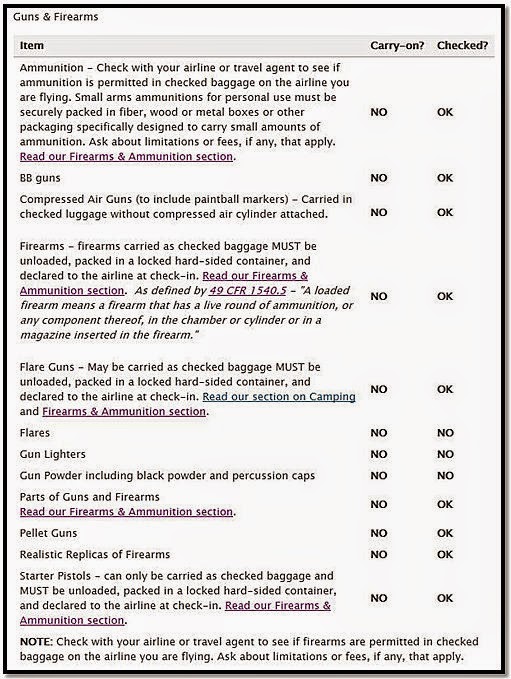
Firearms, ammunition and firearm parts, including firearm frames and receivers, are prohibited in carry-on baggage. Travelers such as target shooters, hunters, collectors, etc., need to travel with their firearms and can do so by checking their firearms and ammunition as checked baggage, as long as proper packing guidelines are followed.
Before I go any further, please take note: Firearm possession laws vary by state and locality. Travelers should familiarize themselves with state and local firearm laws for each point of travel prior to departure. For example, while firearms can be declared and checked with baggage in Cincinnati, it’s illegal in New York City due to possession laws. Airlines may have additional requirements for traveling with firearms and ammunition. Travelers should also contact the airline regarding firearm and ammunition carriage policies.Also, please note that other countries have different laws that address transportation and possession of firearms. If you are planning to travel internationally, check the regulations of the destination country to ensure compliance with their requirements.
Failure to adhere to the following regulations will preclude passengers from traveling with firearms, ammunitions or firearm parts. These regulations are strictly enforced and violations can result in state and local criminal prosecution, as well as civil penalties of up to $2,000 per violation.
- Travelers must declare all firearms to the airline during the ticket counter check-in process.
- The firearm must be unloaded.
- The firearm must be in a hard-sided container.
- The container must be locked. A locked container is defined as one that completely secures the firearm from being accessed. Locked cases that can be pulled open with little effort cannot be brought aboard the aircraft.
- If firearms are not properly declared or packed, TSA will provide the bag to law enforcement for resolution with the airline. If the issue is resolved, law enforcement will release the bag to TSA so screening may be completed.
- TSA must resolve all alarms of checked luggage. If a locked case containing a firearm alarms, TSA will contact the airline, who will make a reasonable attempt to contact the owner and advise the passenger to go to the screening location. If contact is not made, the container will not be placed on the aircraft.
- If a locked container alarms during screening and is not marked as containing a declared firearm, TSA will cut the lock in order to resolve the alarm.
- Travelers should remain in the area designated by the aircraft operator or TSA representative to take the key back after the container is cleared for transportation.
- Travelers must securely pack any ammunition in fiber (such as cardboard), wood or metal boxes or other packaging specifically designed to carry small amounts of ammunition.
- Firearm magazines and ammunition clips must be securely boxed or included within a hard-sided case containing an unloaded firearm.
- Small arms ammunition, including ammunition not exceeding .75 caliber for a rifle or pistol and shotgun shells of any gauge, may be carried in the same hard-sided case as the firearm, as long as it follows the packing guidelines described above.
- TSA prohibits black powder or percussion caps used with black powder.
- There are certain limited exceptions for law enforcement officers who may fly armed by meeting the requirements of Title 49 CFR § 1544.219. Law enforcement officers should read our policies on traveling with guns.
Please be sure to double check your coats, bags and other personal items to ensure you don’t absentmindedly bring a firearm through the checkpoint. One of the most common reasons given when guns are found in carry-on bag is: “I didn’t know that was there!”
Link: Traveling With Firearms and Ammunition on Commercial Aircraft
- Login to post comments


Recent comments
9 years 11 weeks ago
9 years 31 weeks ago
9 years 35 weeks ago
9 years 38 weeks ago
9 years 40 weeks ago
12 years 6 weeks ago
12 years 20 weeks ago
12 years 40 weeks ago